Comprehensive Guide to a Successful Bath Redo
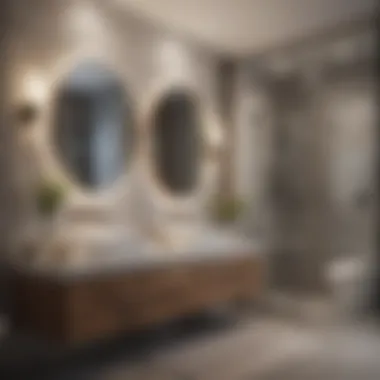
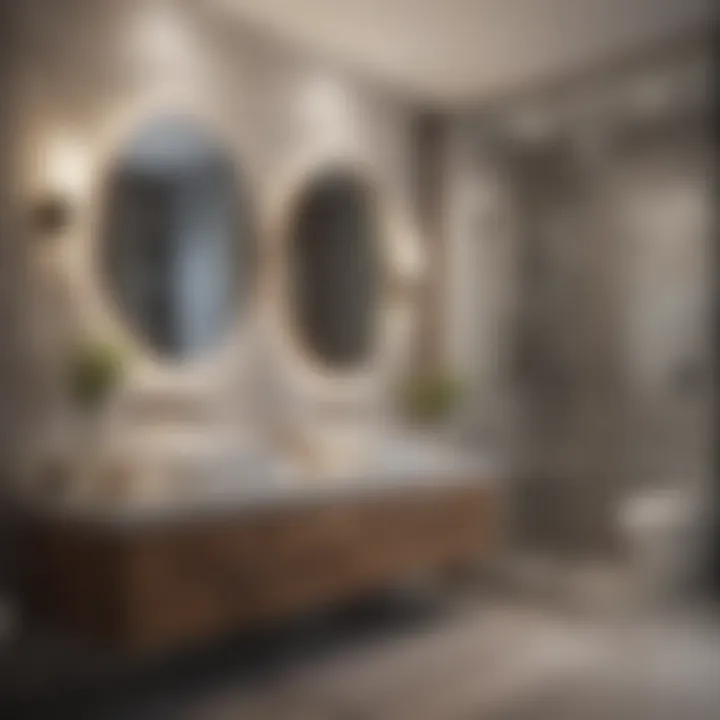
Intro
Renovating a bathroom is a significant undertaking. It involves thoughtful planning and creativity. A bath redo can elevate the entire home's aesthetic and increase its functionality. This guide serves as a resource for homeowners and lifestyle enthusiasts who wish to transform their bathing spaces into serene retreats.
Throughout this article, we will explore the various steps involved, from understanding current trends to selecting the right materials. Our goal is to assist you in creating a bathroom that is both elegant and practical, ensuring that it meets your personal needs and style preferences.
Current Trends
Color Palettes
Color choices play a crucial role in bathroom design. Soft tones like pastels create a calm atmosphere. In contrast, bolder colors such as deep blues and greens can add a touch of drama. Utilizing neutrals like whites and grays allows for versatility, making it easier to change small decor items without a complete overhaul. Here are some popular color trends:
- Soft, muted colors for a relaxing vibe.
- Bold, vibrant hues for a statement look.
- Earth tones, providing a natural feel.
Popular Styles
Design styles can dramatically influence the overall look of a bathroom. From contemporary to rustic, each style brings unique characteristics. Here are a few noteworthy trends:
- Modern: Emphasizes clean lines and minimalistic elements.
- Farmhouse: Combines warm woods with vintage-inspired fixtures.
- Industrial: Incorporates raw materials and a more rugged aesthetic.
These trends can help guide your selections, ensuring that the result aligns with current design preferences.
Visual Ideas
Visual inspiration is key in the design process. Engaging imagery can elucidate how different elements come together effectively.
Gallery of Styled Bathrooms and Bedrooms
Consider creating a gallery of styled spaces that resonate with your vision. This can include:
- Well-organized color palettes.
- Functional layouts.
- Innovative storage solutions.
Before-and-After Transformations
Before-and-after images showcase the power of a redesign. They reveal how careful planning and execution lead to remarkable changes. Seek out transformation examples similar to your initial style to visualize potential outcomes.
Culmination
A bath redo can be transformative, enhancing not just the space but also the overall ambiance of your home. Following the trends, understanding styles, and gathering visual ideas will set the foundation for a successful remodel. By approaching every aspect with consideration, you can create a peaceful and rejuvenating sanctuary that meets your unique needs.
Successful bath renovations require careful thought, creative vision, and an understanding of contemporary trends.
Embarking on this journey might seem overwhelming at first, but with the right guidance, you can navigate the process with confidence.
Understanding the Need for a Bath Redo
A successful bath redo is often prompted by a range of factors that highlight the necessity of an upgrade. The bathroom is one of the most frequently used spaces in a home. Therefore, understanding the underlying issues and the potential for improvement is essential. This section lays the groundwork for identifying these needs, which ultimately inform a more thoughtful and effective remodel.
Identifying Issues in the Current Layout
The first step in considering a bath redo is to identify specific issues with the current layout. This involves analyzing the space to pinpoint areas that are not functioning well.
- Excessive Clutter: Is there lack of proper storage making the space seem cramped?
- Outdated Fixtures: Are the sinks, showers, or bathtubs old, inefficient, or unattractive?
- Poor Layout: Does the flow of movement feel obstructed? For instance, is the toilet too close to the sink?
These observations form the basis for a strategy moving forward. By recognizing the discomfort or inefficiencies present in the current setup, homeowners can prioritize features that need addressing.
Evaluating Functional Requirements
Once the issues have been noted, it is critical to evaluate the functional requirements of the space. This means looking at how the bathroom is used day-to-day and what changes can help improve usability.
- Household Size: For larger families, additional sinks or toilets might be necessary.
- Mobility Concerns: Accessibility features should be assessed. Is there space for grab bars? Is the shower easy to step into?
- Preferred Amenities: Consider features like a double vanity, soaking tub, or walk-in shower. What are the needs and wants?
Understanding these functional requirements will help refine the direction of the redo, ensuring that it meets the practical demands of the household.
Defining Aesthetic Goals
The final component of understanding the need for a bath redo lies in defining aesthetic goals. While functionality is crucial, the visual appeal of a bathroom can significantly impact the overall living experience.
- Personal Style: What looks and feels good? Minimalistic, vintage, or modern? Each choice carries different implications for design.
- Color Scheme: What colors create a calming environment? Consider hues that promote relaxation.
- Material Selection: Choosing the right materials will affect durability and maintenance. For instance, porcelain tiles may offer style but require different upkeep than natural stones.
By clearly defining aesthetic goals, homeowners can create a cohesive design that not only functions well but also reflects personal taste.
Understanding both the needs and desires surrounding your bathroom space leads to informed decisions during the redesign process. Being mindful of these aspects ensures a balance between practicality and beauty.
Planning Your Bath Redo
When considering a bath redo, effective planning is just as essential as the execution itself. This phase serves as the foundation for a successful transformation. It involves determining the scope of work and aligning your dreams with practical realities. By thoughtfully engaging in this planning phase, you ensure that your project is both manageable and aligned with your expectations. Moreover, effective planning helps in avoiding costly mistakes and delays, making it an integral part of any renovation process.
Setting a Realistic Budget
A well-defined budget is the cornerstone of any bath redo. Understanding your financial limits helps set boundaries and guides decisions regarding materials, finishes, and the overall scope of the project. To establish a realistic budget, it is critical to consider the following:
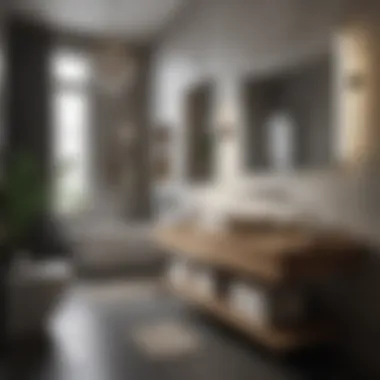
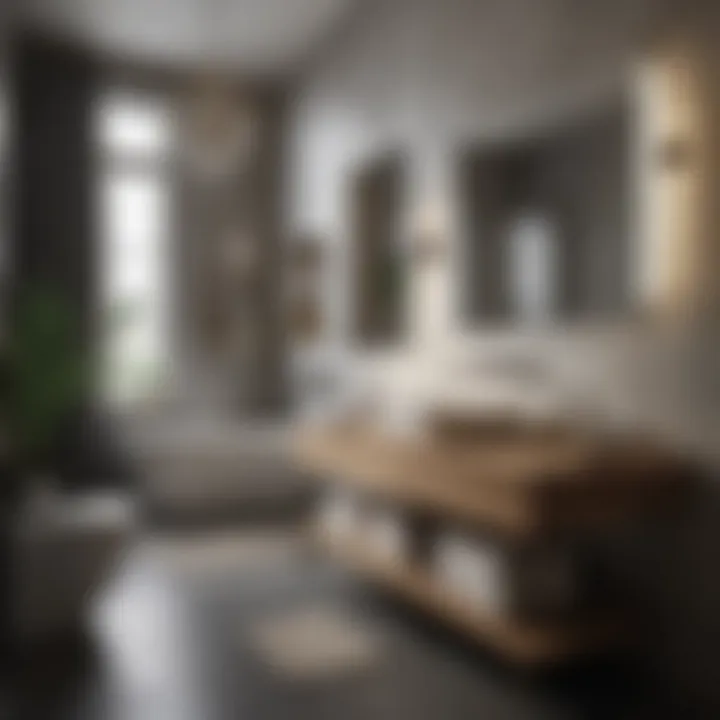
- Define Essential Expenses: List all the critical components needing attention, such as plumbing, cabinetry, tiles, and fixtures.
- Contingency Fund: Add around 10-20% of your total budget as a buffer for unexpected expenses.
- Prioritize Needs over Wants: Focus on what really enhances functionality and comfort, instead of getting carried away by aesthetic choices that may not serve the purpose.
By being mindful of these aspects, you can ensure that your bath redo is financially feasible while achieving your desired outcomes.
Developing a Timeline
Crafting a timeline for your bath redo is essential to manage expectations and maintain workflow. A clear timeline lays out milestones to guide the project from start to finish. Key elements to consider while developing a timeline include:
- Assessment Phase: Set a phase for evaluating the current condition of the bath and deciding on necessary changes.
- Scheduling Contractors: If hiring professionals, confirm their availability and schedule enough time for their work.
- Materials Ordering: Factor in time required for ordering materials, as delays can disrupt the entire project schedule.
This structured approach helps streamline the process, allowing for adjustments when unforeseen situations arise.
Creating a Design Brief
A design brief acts as a blueprint for the bath renovation project. It captures your vision and serves as a guiding document throughout the entire phase. In drafting a design brief, it is important to include:
- Visual Inspirations: Collect images and ideas that resonate with your style to help communicate your vision.
- Functional Requirements: Identify specific needs, such as additional storage or accessibility features.
- Preferred Materials and Finishes: Specify any desired materials that align with your budget and aesthetic goals.
By formulating a comprehensive design brief, you create a coherent narrative that brings clarity to your vision. This essential document not only assists professionals in understanding your preferences but also helps you remain focused throughout the project.
Design Considerations for Your Bath Redo
Design considerations are critical in the bath redo process. A bathroom is not just a functional space; it's a retreat that combines relaxation and rejuvenation. Thoughtful design helps achieve this balance, enabling the user to create an environment that meets both practical needs and aesthetic desires. Here, we will explore different aspects of design considerations that ensure a successful bath redo.
Selecting the Right Style
Style is the foundation of any design project. Choosing the right style involves identifying elements that resonate with you while also considering the overall atmosphere you wish to create. Popular styles to consider include contemporary, traditional, modern farmhouse, and minimalist. Each style has specific characteristics that influence layout, fixtures, and color schemes.
To select the right style, assess your existing home decor and consider how the new bathroom will correlate with it. Look for inspiration in magazines, websites, and social media platforms. Create a mood board to visualize your desired look. This can include images, fabrics, and color samples that inspire you. Additionally, think about the long-term aspects of the style you choose. Will it stand the test of time, or is it a fleeting trend? This is crucial for maintaining the value of your home.
Incorporating Accessibility Features
Accessibility is paramount when redesigning a bathroom. No matter the age or ability of users, it is essential to incorporate features that enhance usability for all. Simple changes can make a significant difference. For example, consider installing grab bars for safety, curbless showers for easy access, and adjustable shower heads to accommodate users of different heights.
Before finalizing any design, evaluate the specific needs of household members or potential users. Features such as wider doorways, lower sink heights, and non-slip flooring add functionality. These considerations not only improve daily comfort but also enhance the home’s appeal in the market.
Choosing Appropriate Colors and Materials
Colors and materials play a significant role in creating the mood and functionality of your bathroom. Light colors often project an impression of space and cleanliness, while darker shades can provide a sense of coziness and sophistication. Consider using a mix of both to create depth.
Material choices are also critical. Selecting moisture-resistant materials like ceramic tiles, glass, or quartz for surfaces can increase durability. Natural materials, like wood for cabinetry, can add warmth if treated properly.
When choosing colors and materials, keep in mind the balance between aesthetics and practicality. Certain materials may provide visual appeal but could require excessive maintenance. It is also important to ensure that chosen materials can withstand humidity and are easy to clean.
"The design choices made in your bath redo are central to maintaining the comfort and beauty of this space."
Essential Elements of a Bath Redo
In any bath redo, focusing on essential elements is crucial to transforming the space into a sanctuary. Every component, from the vanity to the lighting, plays a role in the functionality and aesthetic appeal of the bathroom. Understanding these elements will help to create a cohesive design that meets both practical and stylistic needs. The integration of these features boosts not only comfort but also increases home value, making it a worthy investment.
Vanity and Storage Solutions
The vanity serves as a focal point in a bathroom. It is where functionality meets design. A well-selected vanity includes storage that addresses the need for organization while enhancing the overall esthetic of the room. When choosing a vanity, consider the size of the bathroom and personal needs.
- Storage options: Evaluate the available storage. Open shelves may work for those who prefer easy access, while closed cabinets are better for keeping miscelanious items hidden.
- Materials: Materials used in vanities should withstand moisture. Options like plywood, marine-grade plywood, and even solid wood with good sealing can be durable choices.
- Style: The vanity should complement the overall design of the bath. Whether going for a modern finish or a more classic look, it should align with other decor elements.
Shower and Bathtub Selection
Choosing the right shower and bathtub is vital for creating a functional bathing area. Individual preferences vary widely here, making this a critical decision in any redo.
- Type of Bathing Fixtures: Determine if a separate shower, a bathtub, or a combination of both is the right choice. Freestanding tubs create a luxury feel, while walk-in showers can save space.
- Size: The dimensions of the bathroom often dictate what options are available. Ensure that there is enough space for easy movement.
- Water Efficiency: Opt for fixtures that conserve water, contributing to sustainability goals. Many brands offer high-efficiency models that do not compromise on performance.
Lighting and Ventilation Updates
Good lighting and proper ventilation are often overlooked yet essential elements in a successful bath redo. They significantly influence the atmosphere and functionality of the space.
- Lighting Layering: Use a combination of ambient, task, and accent lighting to create a well-lit area. Sconces or recessed lights above mirrors help in grooming tasks, while softer ambient lighting enhances relaxation.
- Ventilation: A bathroom must be adequately vented to prevent issues like mold and mildew. Consider installing a high-quality exhaust fan to remove excess moisture and ensure air circulation. Exhaust fans should also be quiet enough not to disrupt the tranquil atmosphere of the bath.
By prioritizing these essential elements, homeowers can create a bathing retreat that is not only stylish but also practical.
Understanding these aspects of a bath redo ensures that each choice serves a purpose and adds to the overall experience. By investing the time into thoughtful decision-making, one can enjoy a bathroom that enhances daily routines while also providing a calming escape.
Sourcing Materials and Finishes
When planning a bath redo, sourcing materials and finishes is a crucial step. The materials you select will directly impact both the look and functionality of your new space. Good sourcing can facilitate a smoother renovation process. In contrast, poor choices may lead to delays and dissatisfaction in the final product. Therefore, understanding how to source materials effectively is key for achieving a desirable outcome.
Finding Reliable Suppliers
The first task in sourcing materials is to identify reliable suppliers. It’s essential to seek out companies that have a reputation for quality and service. Start with a bit of research. Look for reviews online and ask for recommendations from friends or family. You may also visit local showrooms to see products in person.
Some factors to consider when evaluating suppliers include:
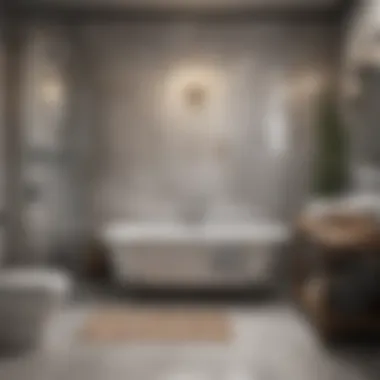
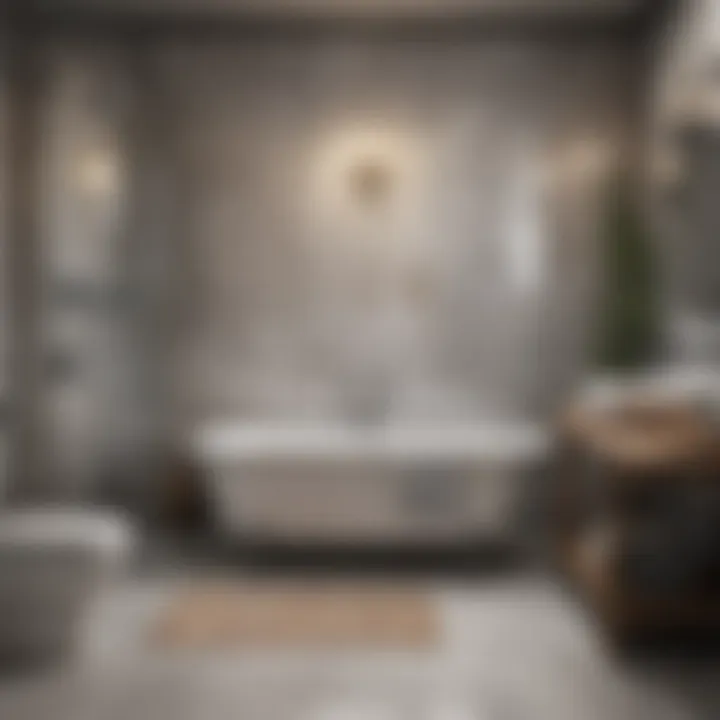
- Product Quality: Ensure the materials meet safety and performance standards.
- Variety of Options: A good supplier should offer a range of styles to fit your vision.
- Customer Service: Effective communication is important for clarity on timelines and costs.
- Return Policies: Know the terms in case a product does not meet your expectations.
Evaluating Quality Versus Cost
When it comes to materials, the balance between quality and cost is often a delicate one. It may be tempting to choose cheaper options, but this can lead to more issues down the line. Evaluate what long-term value each material offers. Investing in high-quality materials, such as durable countertops or water-resistant flooring, can pay off in reduced maintenance and a longer lifespan.
To assist in decision-making, consider these points:
- Performance: How well does the material resist wear and tear?
- Maintenance: Is the material easy to clean and maintain?
- Aesthetics: Does it contribute to the overall look you desire?
- Longevity: Will it stand the test of time, both functionally and stylistically?
Sustainability Considerations
As sustainability becomes more of a priority for homeowners, it’s important to think about eco-friendly choices in your material sourcing. Many suppliers offer sustainable options that do not compromise on quality. This can also appeal to a segment of the market that prioritizes green living.
Factors to investigate include:
- Source of Material: Is it locally sourced? This reduces transportation emissions.
- Manufacturing Process: Are environmentally friendly practices employed?
- Recyclability: Can materials be recycled at the end of their life cycle?
Making sustainable choices may also qualify for tax incentives or rebates, adding a financial benefit to your responsible selection.
"Investing in sustainable materials not only benefits the environment; it can also enhance the appeal and value of your home."
In summary, sourcing materials and finishes involves careful consideration of quality, cost, and sustainability. Taking the time to research can lead to better decisions and a more satisfying renovation experience.
Engaging Professionals for Your Bath Redo
Engaging professionals for a bath redo is an important step in ensuring that your project runs smoothly and meets your expectations. Professionals bring expertise and experience to the table, which can save you time and frustration. When dealing with construction, plumbing, and electrical work, it is prudent to hire licensed experts who are knowledgeable in their respective fields. This not only minimizes risk but also increases the quality of the work done. Homeowners often face various challenges during renovations, and having professionals can help navigate these obstacles effectively.
Identifying Qualified Contractors
Identifying qualified contractors is a critical part of the renovation process. Begin by researching local contractors who specialize in bathroom remodels. Look for reviews on websites like Yelp or Google Reviews, as well as testimonials from previous clients. An effective way to gauge a contractor's quality is by asking for references; speaking directly with former clients can provide insight into their work ethic and reliability.
When considering a contractor, ensure they are licensed and insured. This protects you from potential liabilities that may arise during the renovation. It’s also wise to request a portfolio of completed projects to assess their style and quality. Arrange meetings with a few contractors to discuss your project and evaluate whether their vision aligns with yours.
Understanding Project Management
Understanding project management is essential for a successful bath redo. A well-managed project ensures that tasks get done on time and within budget. Assign a responsible point person, whether that is you or a contractor, to oversee the renovation. This individual will coordinate schedules, supervise tradespeople, and ensure that the project stays on track.
Create a detailed plan that outlines every phase of the renovation, including timelines and budget estimates. Organize regular check-ins to address any issues that arise swiftly. Efficient project management can enhance the overall experience and reduce the stress commonly associated with home renovations.
Establishing Communication Protocols
Establishing communication protocols at the beginning of your project can greatly improve collaboration among everyone involved. Clear lines of communication help minimize misunderstandings, which can lead to delays and increased costs. Outline how you and your contractor will interact, such as through emails, texts, or regular meetings.
Set expectations for response times, addressing how quickly questions and concerns should be handled. Consider using project management software to keep everyone on the same page. This can serve as a platform where you can track progress, share updates, and store important documents. Ultimately, good communication fosters a positive working relationship and helps achieve the bath redo that you envision.
"Effective communication is the foundation of successful project management, especially in renovations."
Engaging professionals during your bath redo not only elevates the potential outcome but also creates reassurance in the process. From identifying qualified contractors to managing the project and establishing communication protocols, each step is vital in transforming your bathroom into a serene retreat.
DIY Bath Redo Options
Embarking on a bath redo can be a daunting journey. However, considering DIY options allows homeowners to save money while also personalizing their space to align with specific tastes. Embracing the do-it-yourself approach encourages creativity, promotes a sense of accomplishment, and deepens the connection with the living environment. Additionally, DIY projects provide flexibility in terms of planning and execution. Whether you are changing fixtures or retiling, taking on these tasks yourself can be incredibly rewarding.
Assessing Your Skill Level
It is paramount to understand your own capabilities before diving into a DIY bath redo. Each renovation task demands a different skill set. Some projects, such as changing faucets, may require only basic tools and skills, while others, like plumbing or electrical work, necessitate an advanced level of expertise.
To assess your skill level:
- Consider past projects: Review prior home improvement tasks you have successfully completed.
- Research necessary skills: Identify what skills are required for the specific tasks involved in your bath redo.
- Be honest with yourself: Recognize your limitations and gauge whether you might need to consult a professional for more complex elements.
Understanding your capabilities will help minimize stress and ensure safety throughout the renovation process.
Essential Tools and Equipment
Having the right tools is crucial for a successful DIY project. Inadequate tools often lead to complications, delays, or damage to materials. Below is a list of essential tools to prepare:
- Measuring tape: For accurate dimensions and ensuring a good fit.
- Level: To make sure installations are precise, particularly for tiles and cabinets.
- Screwdriver set: Essential for assembling or disassembling fixtures.
- Plumber's wrench: Required for tasks involving plumbing changes.
- Tile cutter: If you plan on tiling, this tool will be necessary for proper cuts.
- Safety gear: Goggles and gloves to protect yourself from injuries during renovation.
Investing in quality tools is worthwhile, as it can significantly ease the workload and enhance efficiency.
Step-by-Step DIY Guides
To facilitate a smooth renovation process, having a structured plan with step-by-step guides is beneficial. Here is a simplified process for a typical bath redo:
- Plan the Layout: Sketch out the new layout of the bathroom. Consider functional zones and optimize flow within the space.
- Gather Materials: Based on your project needs, source the appropriate materials and tools. This includes tiles, paint, fixtures, and storage solutions.
- Demo Old Items: Remove existing fixtures, tiles, and cabinets carefully to avoid damaging underlying structures.
- Make Necessary Repairs: If there are plumbing or structural concerns, ensure these are addressed before moving forward.
- Install New Fixtures: Follow the manufacturer’s instructions closely. Proper installation is crucial for functionality and safety.
- Finishing Touches: Add any accessories or decorative elements. Arrange items thoughtfully to enhance the overall appearance.
- Final Inspection: Evaluate the completed work to identify any issues or necessary corrections.
"Taking a methodical approach can make your DIY bath redo a smooth and rewarding experience."
The key to a successful DIY bath redo is preparation, understanding your skills, and having the right tools at your disposal.
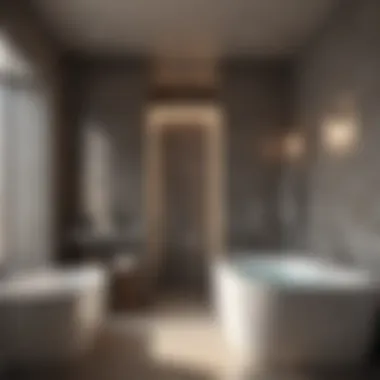
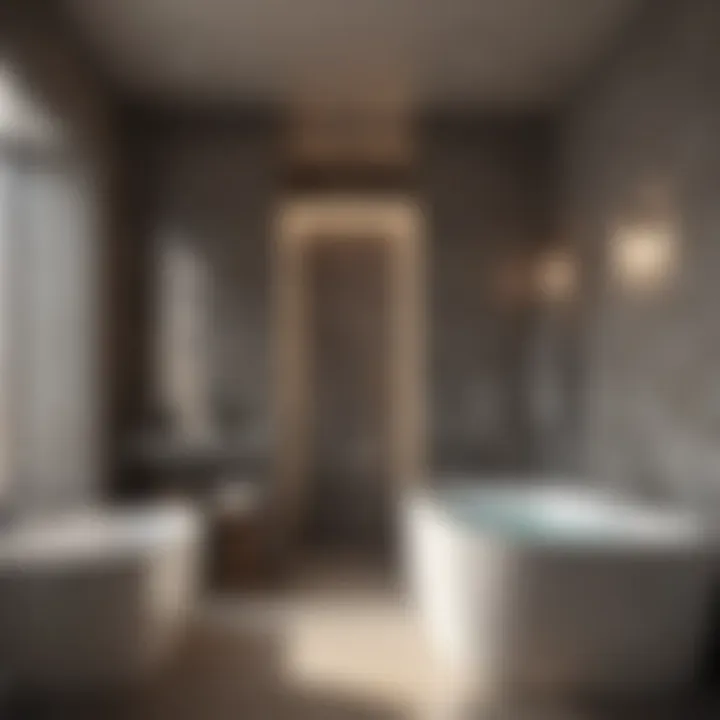
Overcoming Common Challenges
In the journey of a bath redo, challenges can arise that threaten to derail your plans. These challenges vary in nature, but effective strategies can help you navigate them. Understanding how to tackle these issues not only safeguards your investment but also ensures the remodel meets your expectations. Tackling challenges together enables you to create a bathroom that truly reflects your vision.
Addressing Plumbing Concerns
Plumbing issues can be one of the most daunting aspects of a bath renovation. Whether it is replacing old pipes or ensuring proper drainage, these concerns need addressing at the onset. Ignoring plumbing can lead to functional deficiencies in your remodel.
It is vital to evaluate the existing plumbing setup. Check for any leaks, water pressure problems, or outdated pipes. If necessary, engage a qualified plumber early in the process. They can provide insights on what needs replacing or updating. A proactive approach can save you from costly repairs in the future. Remember, sometimes it is more affordable to upgrade plumbing while the space is under construction rather than waiting until after the project is complete.
Dealing with Unexpected Expenses
Unexpected expenses often emerge during any renovation project. It is essential to prepare for these scenarios as they can impact your overall budget. It is wise to allocate approximately 10-20% of your budget for unforeseen costs. This allowance helps cover anything from unexpected plumbing issues to last-minute material changes.
Researching costs ahead of time can minimize surprises. Seek detailed quotes from contractors and suppliers. Ensure you ask about extra charges or fees that could arise. According to data from reddit.com, many homeowners fail to budget for surprise costs adequately, leading to stress and frustration. Keeping a detailed record of your spending throughout the process is a helpful habit. This transparency in finance can provide clarity and help you make decisions without rushing.
Managing Time Constraints
Time is often a crucial factor in the success of a bath redo. Homeowners typically desire minimal disruption to their daily routines. Therefore, effective time management is key.
A detailed project timeline should be established at the beginning. Consult with contractors about how long various tasks will take. For instance, demolition may take a few days, while tiling might require a week or more.
Communicating openly with your team can help stay on track. Understand that while delays may happen, having a clear timeline can aid you in managing expectations. By monitoring progress regularly, you can ensure that the project is heading toward completion on schedule.
"Effective management of time and budget can be the defining factor between a successful renovation and a stressful one."
In summary, addressing plumbing concerns, preparing for unexpected expenses, and managing time constraints are vital to overcoming the challenges of a bath redo. Keeping these strategies in mind will enable you to navigate changes effectively and enhance your satisfaction with the newly remodeled space.
Final Touches and Decor
The final stages of a bath redo hold significant value. They are essential for transforming a merely functional space into one that exudes style and comfort. The careful selection of final touches and decor brings your vision to life, ensuring that the bathroom serves as a true sanctuary. This phase includes the choice of accessories, textiles, and color schemes that complement the overall design while enhancing both beauty and functionality.
Selecting Accessories
Accessories can dramatically influence the look of your bathroom. These items add personality and style, making the space uniquely yours.
When selecting accessories, consider the following:
- Type: Choose items that match the overall aesthetic of your bathroom. For example, modern bathrooms may benefit from sleek, metallic finishes, while traditional spaces may call for ceramic or wooden accents.
- Functionality: While aesthetics are important, the functionality of accessories cannot be overlooked. Items such as soap dispensers, towel holders, and shelves should not only look good but also cater to the daily activities in the bathroom.
- Scale: Ensure that the size of the accessories is appropriate for your space. Oversized items in a small bathroom can make the area seem cramped, while too-small items may be lost in a larger room.
Incorporating Textiles and Color
Textiles play a pivotal role in establishing a warm and welcoming atmosphere. Incorporating the right textiles can soften the starkness of tiles and fixtures.
- Towels and Bathmats: Choose towels and bathmats that add color or texture. These items can be easily changed seasonally for a fresh look. Consider cotton for softness and absorbency.
- Curtains or Blinds: Window treatments should complement the overall theme. For example, sheer curtains can provide privacy while allowing light to filter through. Alternatively, wood blinds can offer a more modern touch.
- Color Palette: When considering color, opt for hues that unify the space. Soft neutrals can create an airy feel, while bold colors can act as focal points. Always test paint colors in the actual space to see how they interact with natural light.
"The right accessories and colors can elevate your bathroom from a routine space to a serene retreat."
Creating a Cohesive Look
A cohesive look is crucial for a well-designed bathroom. When every element complements one another, the impact is both aesthetic and functional.
- Theme Consistency: Keep a consistent theme throughout. This might mean staying within a specific color palette or replicating a style such as modern, rustic, or coastal.
- Visual Balance: Distribute visual weight evenly throughout the space. This might involve balancing bold colors with neutral tones or heavy fixtures with lighter ones.
- Personal Touches: Adding personal items, such as framed photographs or artwork, can help create a unique atmosphere. However, these should be curated to avoid visual clutter.
Overall, the final touches and decor of your bathroom setup are not merely trivial. They encapsulate the results of your entire renovation, knitting together style and usability into a seamless experience.
Both functionality and beauty matter as you finalize the transitional space. With careful selection and attention to detail, your bath redo can become a lasting sanctuary.
Post-Renovation Considerations
In any bath redo, the mere act of renovating is just the beginning. Post-renovation considerations are essential to ensuring that the new space continues to function optimally and maintains its aesthetic appeal over time. Reflecting on what has been achieved and how to keep it at its best can lead to greater satisfaction with the renovation. The focus of this section is on maintaining your new space, gathering feedback, and thinking about long-term improvements.
Maintaining Your New Space
After completing your bath redo, it’s vital to implement a routine maintenance schedule. Daily upkeep includes simple tasks such as wiping down surfaces and checking for leaks. Regular cleaning helps to preserve the beauty of new vanities, tiles, and fixtures. Following a weekly plan can be useful. For instance:
- Clean glass surfaces with a gentle cleaner to prevent buildup.
- Inspect plumbing fixtures monthly to catch any potential leaks early.
- Deep clean the entire space at regular intervals to maintain it fresh.
By establishing consistent practices for maintaining your bathroom, you ensure that all elements stay functional and aesthetically pleasing. Regular maintenance avoids long-term costs related to repairs or replacements, allowing you to enjoy the results of your remodel.
Gathering Feedback Following Completion
Once the renovation is done, it is crucial to assess success through feedback. Gathering different perspectives can highlight what works and what does not. Engaging family members can provide insights on usability as well as overall satisfaction with the design. It is prudent to ask:
- How does the new space meet your needs?
- Are there areas of the design that are confusing or challenging to use?
- Would you recommend any changes?
Feedback collection can be structured with simple questionnaires or casual discussions. Having diverse viewpoints can enhance your understanding of the functionality and comfort of the space. Any new suggestions can lead to minor adjustments that significantly improve the overall experience of using your bathroom.
Long-Term Improvements and Adjustments
As life progresses, needs change. Long-term improvements to the bathroom can enhance your space further and keep it aligned with your lifestyle. It’s advisable to remain flexible in adapting the space to meet new demands.
Consider the following aspects for ongoing improvement:
- Updating fixtures and finishes over time to prevent wear.
- Implementing new technology, like smart toilets or lighting systems.
- Redecorating with seasonal changes in mind to keep the space feeling fresh.
Planning for adjustments allows you to customize your bathroom as your preferences evolve. Investing in quality materials can also ease transitions since durable designs are often easier to adapt. The aim is to ensure your bathroom continues to serve as a peaceful sanctuary for years to come.



